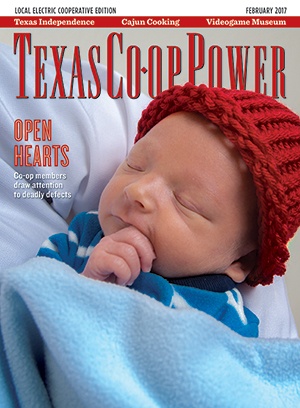Nearly every catastrophe one could imagine has befallen United Cooperative Services for the past ten years.
There was an F4 class tornado that nearly leveled the co-op’s storm-hardened Eastern District Office in Burleson; there was an ice storm that laid waste to much of the cooperative’s distribution network; there was a snow storm tied to an influenza pandemic that not only paralyzed mobility, but also weakened the cooperative’s work force.
Then there were the wildfires, and the summer day when a Brazos Electric Power Cooperative substation equipment failure triggered the loss of power to seven substations, and affected 16,000 meters across United’s eastern service area.
The mayhem has been unforgiving and relentless, piled on the cooperative year after year.
And yet, the spate of peril has mostly come and gone without notice by others outside the cooperative.
Even though some of the adversity described above has been based on actual events the cooperative has weathered in the past, most have been tabletop exercises United orchestrates year-round as a test of the cooperative’s emergency response planning and preparedness.
Much like other types of emergency drills, the cooperative responds to every exercise as if it were a reality, and then, at its conclusion, examines and dissects how effective the company’s procedures and protocols were in United’s virtual response to the event.
To be sure, as far-fetched as some of the emergency sketches may seem, they can and occasionally do mirror real events.
Naturally, United has responded to common threats like wildfires and intense storms, but new hazards have evolved over time. For instance, the cooperative continues to expand its emergency readiness to include emergency management and response capabilities that thwart attacks on information technology (IT). Cyber security threats are as real for electric utilities as they already have been for victims in the political, internet search and big box retail sectors.
And since electric providers have been deemed a part of the nation’s critical infrastructure, state and federal lawmakers have taken more interest in safeguarding the electric grid, and have even challenged the electric industry to establish contingencies for an electromagnetic pulse (EMP) attack—weapons thought capable of crippling whole electrical systems and power grids.
The annual exercises aren’t taken lightly because restoring power after a major event is a complex task that must be completed as safely and efficiently as possible.
Every restoration process, widespread or localized, is unique and requires significant logistical coordination, skilled workers and specialized equipment.
As a requirement of both the Rural Utilities Service (an Agriculture Department lending branch established to serve cooperatives) and the Public Utility Commission of Texas (PUCT), and because the cooperative has always clung to the tenet of providing superior service value to its members, United regularly plans and prepares for as many emergency situations as possible, and preferably before such an event actually occurs.
As a result, the co-op each year gathers a team of representatives from nearly every department to evaluate and develop detailed plans and priorities for restoring electricity during an invented emergency. The tests serve as dress rehearsals for an infinite variety of emergency events and any ensuing outages they might cause.
Every exercise tests proper guidelines and procedures for addressing damage assessment, acquisition and distribution of replacement material, environmental clean-up, internal and external communications, mobility and access to affected areas, coordination with area emergency management teams, interaction with National Incident Management System (NIMS) and the Federal Emergency Management Agency (FEMA), etc.
“Even though developing and updating the Emergency Response Plan document each year is a requirement that takes considerable effort to complete, our regular review of emergency scenarios and our preparation for extraordinary events is always a good practice for any business in my opinion—especially so for an electric distribution cooperative,” said United Senior VP of System Engineering Quentin Howard. “We have a professional and moral obligation to our members to devise as many practical solutions to sudden widespread power losses as possible, and to have planned in advance for the worst of imagined events.”
Part of every power restoration effort, for example, includes a determination for how many critical accounts are affected (hospitals, police and fire stations, water reclamation plants, communications systems and where continuous power is needed to sustain a member’s health).
Another important aspect of any restoration effort is a time-consuming but necessary assessment of damage sustained across United’s distribution system.
From there, the cooperative’s line crews are dispatched to repair primary circuit lines that will return service to the largest number of customers in the least amount of time.
Primary service lines to neighborhoods, industries and businesses must be systematically restored before service to individual homes and smaller groups of members is restored.
Howard said there are many moving pieces in a major restoration effort, and that’s why advance planning is absolutely necessary in validating and benchmarking response and recovery capabilities, and identifying areas that need improvement to achieve a perpetual state of readiness.
“The Emergency Response Plan, or more specifically the annual table top exercise, provides us the opportunity to review the roles of various cooperative departments (information systems, operations, communications, etc.) and the processes and protocols they would observe and use during a restoration effort—ensuring every department is prepared for specific “disaster” scenarios,” Howard said. “Generally, a few areas are identified each year that need adjustment or improvement. The exercises give us an opportunity to correct those issues without suffering the consequences of not being well-prepared during the real thing.”
Delivering safe, reliable and affordable power to its membership remains at the core of United’s identity and, in an increasingly plugged-in world, those service attributes have become even more important.
“We’ve never met a restoration event yet that United hasn’t or wouldn’t have been able to overcome,” Howard said. “We had never planned for an extreme wildfire event during these exercises, for example, but previous emergency response planning aided us in 2011 when we completely restored devastating Possum Kingdom Lake wildfire line and pole losses (400-plus) in a total of nine days rather than the 31 days predicted at the onset of our response.”
“In that case, it was an emergency response drill learned in the field, but we think our success in that restoration campaign showed the value derived from predictive planning and the continual development of viable response strategies, especially when the unimaginable really happens,” he said.
Planning and conducting various levels of exercises and drills that cover myriad threats to United’s infrastructure are essential for sustaining emergency readiness, and ensuring power continuity and data protection.
And to that end, United never fails to prepare. Standing ready is part of the cooperative’s promise to provide safe, reliable and affordable electric service to its members every day.


